Scarab superfamily is a large and unique group in Coleoptera, commonly known as branchioceratops. It is easy to identify because the 3-8 segments at the end of the antennae extend to the front and are tip-like or gill-flap-like, thereby defining the category of the group. , such insects are generally referred to as scarabs. The heads of scarab beetles are often small, mostly with front mouth type, and the rear part extends into the pronotum. The mouthparts are well developed, especially the upper jaw is very well developed and strong. The tentacles are usually not very long, consisting of 8-11 segments, with the majority having 9 or 10 segments. The gills are composed of 3-8 segments at the end, with the majority having 3 segments. The pronotum is large, usually wider than long, and the lateral edges are more or less arcuate. Most taxa have prominent scutels, and many genera have missing scutels. The forewings are elytra, and the hind wings are well developed and good at flying. In a few species, the hind wings are degenerated and the ability to fly is lost and they can only crawl. There is no opening behind the base fossa of the forefoot. The feet are digging type, with teeth on the outer edge of the tibia of the forefoot, 1 distal distance (or inner edge distance), and 5 tarsal joints. There are very few species with less than 5 tarsal joints, only 4 or 3 joints. There are 5-6 webs visible in the abdomen. The abdominal spiracles are located on the lateral membrane between the dorsal webs or at the upper end of the web side. The last dorsal web forms the buttocks. They are either covered by the elytra or exposed outside the elytra. The above abdominal characteristics are one of the classification basis under the general family. Some taxa have obvious sexual dimorphism. The males have various horns or protrusions on the head and front of the thorax, or the gills of the antennae have more segments than the females.
The larvae are often curved in a "C" shape and are called grubs. They have a soft and milky body with 3 pairs of thorax and legs, no tail process, and a sieve-shaped spiracle. They have 3 instars during the entire development process. They live in the soil and feed on the roots of plants or organic matter in the soil. , or live on animal dung, decayed wood, carrion or fungi, and animal debris.
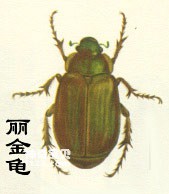
1. Scarabidae
Most species are brightly colored, with metallic sheen such as bronze, verdigris, dark green, etc. Many species have monotonous body colors, such as brown, brown, black, yellow, etc. They range in size from small to large, with most being medium in size. The body is mostly oval or elliptical, and the back and ventral surfaces are both arched. The mouth is in front of the head, the head and face are mostly simple, the antennae have 9-10 sections, with most having 9 sections, and the gills are all composed of 3 sections. The front and back of the chest are wide and broad, and the front is narrow and the back is wide. The scutes are well developed and triangular. The posterior side of the posterior thorax and the lateral ends of the base of the hind foot are not exposed. Hip plate exposed. The chest is covered with downy hair. The feet are well developed, with two distal ends at the middle and rear feet. Each foot has one pair of claws, which vary in size. The end of the larger claw of the two claws of the front and middle feet is often split into two branches.
So far, nearly 3,000 species of golden turtles have been recorded in the world, and nearly 400 species have been recorded in my country. Adults harm the above-ground parts of plants, while larvae (grubs) eat crops and underground parts of plants. They are important underground pests. The bronze-green beetle is widely distributed in China's Heilongjiang, Jilin, Liaoning, Inner Mongolia, Ningxia, Gansu, Hebei, Shanxi, Shaanxi, Shandong, Henan, Jiangsu, Anhui, Zhejiang, Hubei, Jiangxi, Hunan and Sichuan; its distribution abroad is recorded as Mongolia, North Korea.
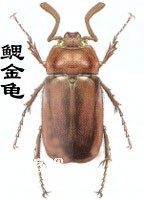
2. Branchiocaratidae
The branchial beetles are the largest family among the branchioceratops, with more than 10,000 species recorded so far, and more than 500 species are known in my country. There are various types of beetles, ranging from small to large, with most species being medium-sized. The body is oval or elliptical, and the body color is relatively monotonous, ranging from brown to dark brown, or all of the same color, or with various markings, with strong or weak luster, which is not unrelated to their habit of being active at night. The mouthparts of the head are located under the lip base, and the back side is not visible. The antennae have 8-10 sections, and the gills have 3-8 sections, with 3 sections being the most. The pronotum is usually wider than long, the base is equal to or slightly narrower than the base of the elytra, and the mesothorax is not visible on the back. The small scutes are prominent and mostly triangular. The elytra are well developed, with four longitudinal ribs often visible. Most of the hind wings are well developed and capable of flying, but there are also a few species whose hind wings are degenerated and unable to fly. The hip plate is exposed and not covered by the elytra. There are 1 to 3 teeth on the outer edge of the tibia of the forefoot, and 1 spur on the inner edge. The midfoot and hind tibia each have 2 spurs. There are basically the same pair of claws. There are also some species with 2 on the front foot and middle foot. The claws vary in size, and there is only one claw on the hind foot. There are many species of Brachyphoraidae that are important agricultural and forestry pests and underground pests with great economic significance.
The Northeastern giant black gill beetle is widely distributed in Heilongjiang, Jilin, Liaoning, and Hebei (north) of my country, as well as Mongolia, North Korea, and the Far East of Russia abroad.
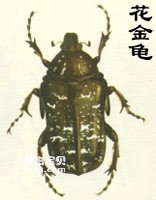
3. Scarabidae
The Chrysanthemum family is a large family of branchioceratops and is a sunrise group with many bright colors. The main characteristics are: they are mostly medium to large beetles, with very strong body walls, well-developed lip base on the head and face, and the base side is concave in front of the compound eyes, making the base of the antennae visible on the back. The antennae have 10 segments and the gills have 3 segments. The pronotum is narrow in front and wide in back, trapezoidal or slightly oval, and can be seen between the angles of the side edges. Scutum well developed, triangular. The elytra are wide at the front and narrow at the back, and there are often 2 strong longitudinal ribs on the back. The posterior side of the metathorax and the lateral ends of the hindfoot bases are visible on the back. The hip plate is well developed, mostly in the shape of a short broad triangle. There are various mesothoracic and abdominal processes between the base segments of the midfoot. The feet are often short and strong, and there are also types with slender legs. There are 1 to 3 teeth on the outer edge of the tibia of the forefoot, and the tarsal segments mostly have 5 segments, and a few have 4 segments.
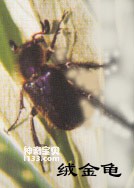
4. Velvet Beetles
The Velvet Beetles are a small family of branchioceratops with few species. The identification characteristics are that the body is relatively long and narrow, hairy, and often has a metallic luster. There are no protrusions on the head, surface and pronotum. The antennae have 10 segments and the gills have 3 segments and are sparsely hairy. The mouth is in front of the head, the lip base is somewhat narrower than the forehead, the upper lip and palate are well developed and exposed, and the back side is visible. Pronotum narrower than wing base. Scutum lingulate. The elytra are long and narrow, with 2-3 longitudinal ribs or missing. The hip plates are somewhat exposed, and 6 webs are visible on the abdomen. The ventral surface of the body is densely covered with hairy spots. The legs are slender and the claws are in simple pairs. Adult beetles damage the flower organs of plants. For example, the common long-horned beetle is distributed in Gansu and Shanxi.
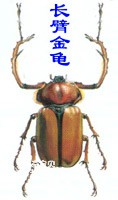
5. Brachiidae
There are very few species of beetles. So far, only about 20 species have been recorded in three periods, and about 4 species have been recorded in my country. There are many extra-large species in this family, with various body colors, either with golden green, dark green, golden blue luster, or with single color of yellowish brown or chestnut brown. The body is long and oval, with a rather arched back, and its front legs, especially those of males, are particularly elongated as a family-level characteristic. The head is small, the mouthparts are covered by the lip base, and the back is not visible. The antennae have 10 segments and the gills have 3 segments. The pronotum is very broad, the strength on both sides expands laterally, and the lateral edges are deeply serrated.
The genus Colored-armed Scarab is mainly distributed in the Oriental region, and the genus Brown-armed Scarab is mainly distributed in Asia Minor, West Asia and other places in the Palearctic region. The Yangcai-armed beetle is a species with slightly more distribution points in my country. Distributed in Jiangsu, Zhejiang, Jiangxi, Hunan, Guangdong, Hainan, and Guangxi in China; there are reports of distribution in Vietnam abroad.
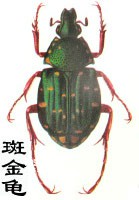
6. Scarabidae
The Rhinocerosidae are a small family of branchioceratops. The main identification features are: the base of the lip is somewhat concave in front of the compound eye, so the base of the antennae is visible on the back; the antennae consist of 10 segments and the gill lamellae are composed of 3 segments; the length and width of the pronotum are nearly equal or wide, narrow in front and narrow on the sides. The margin is curved, the middle section is the widest, and the base is obviously narrower than the wing base; the posterior side of the mesothorax is usually invisible when looking down between the elytra of the prothorax; the scutes are smaller and triangular; each foot is relatively slender, and the outer edge of the tibia of the forefoot is l- There are 3 teeth, 5 tarsal segments on each foot, and simple claws in pairs. There are more than 200 species recorded in the world, and nearly 30 species have been recorded in my country, such as the short-haired beetle.

7. Beetleidae
The beetles, also known as the beetles or beetles, are one of the smaller groups of branchioceran beetles. The body is narrow, long and oblate, the back of the elytra is often flat, and the whole body is black and bright. The head is front-mouthed, and the back of the head is uneven and has multiple protrusions. The upper lip is prominent, the upper jaw has a movable small tooth, the lower lip is deeply concave, and the outer mandibular lobe is hook-shaped. The antennae have 10 segments, often bent rather than elbow-shaped, and have 3-6 pectinate segments at the end. The pronotum is large and the small scutes are missing. The elytra have obvious longitudinal groove lines. The back of the abdomen is completely covered by elytra. Both adults and larvae feed on rotten wood. There are reports of male and female parent insects living in the same burrow with the larvae, and the parent insects chewing up dead wood for the larvae to eat.
Most of them are distributed in tropical areas, with nearly 600 species known in the world, and 9 species in 5 genera have been recorded in my country.
animal tags:
We created this article in conjunction with AI technology, then made sure it was fact-checked and edited by a Animals Top editor.